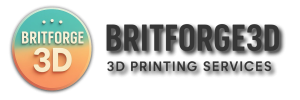Understanding Print Orientation and Part Strength

Guides
Understanding Print Orientation and Part Strength
Print orientation is one of the most important yet often overlooked aspects of successful 3D printing. How a part is positioned on the print bed affects not only how it looks but also how strong it is in real-world use. At BritForge 3D, we evaluate each model to ensure it’s oriented for the best balance of strength, accuracy, and surface finish.
What Is Print Orientation?
Print orientation refers to how your 3D model is positioned during the printing process. This determines how layers are built up, how supports are generated, and how forces act on the finished part.
Why Print Orientation Matters
- Part Strength: FDM prints are weakest between layers. Orient your part to resist stress across layers.
- Surface Finish: Vertical surfaces print smoother than horizontal overhangs.
- Print Time & Supports: Orientation affects how much support material is required and how long a print takes.
- Accuracy: Flat surfaces on the print bed come out cleaner and more dimensionally accurate.
Layer Adhesion and Strength
In FDM 3D printing, parts are built layer by layer. The bond between layers isn’t as strong as the material itself, which means parts can be prone to delamination under stress especially if printed in the wrong orientation. For maximum strength, orient parts so the load is parallel to the layers.
Examples of Optimal Orientation
- Brackets: Print with the flat face on the bed and the arms upright to handle load across the layer lines.
- Hinges or Clips: Align so stress points run along, not between, layers.
- Decorative Models: Choose orientation for better detail visibility and smooth surfaces.
Support Material Considerations
Changing orientation can dramatically reduce the need for supports saving time and material. Parts printed with minimal overhangs are easier to post-process and have a better finish.
Tips for Better Print Orientation
- Minimise large overhangs (greater than 45°)
- Orient parts with the flattest side down for bed adhesion
- Consider the functional load design for it!
- Use preview features in slicing software to evaluate orientation
How BritForge 3D Helps
When you upload a file to BritForge 3D, we assess print orientation to ensure it meets your needs. Whether you’re making a working part or a display model, we tweak orientation, supports, and slicing settings to optimise every job.
Conclusion
Understanding how orientation affects 3D printed part strength can be the difference between success and failure. Our team at BritForge 3D takes the guesswork out delivering durable, high-quality prints designed for real-world performance.
